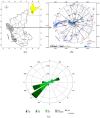Environmental transfer parameters of strontium for soil to cow milk pathway for tropical monsoonal climatic region of the Indian subcontinent
- PMID: 35534517
- PMCID: PMC9085734
- DOI: 10.1038/s41598-022-11388-1
Environmental transfer parameters of strontium for soil to cow milk pathway for tropical monsoonal climatic region of the Indian subcontinent
Abstract
The radionuclide transfer between compartments is commonly described by transfer parameters representing the ratio of concentrations of an element in two compartments for equilibrium conditions. This is a comprehensive study on the soil-to-grass transfer factor (Fv) and grass-to-cow milk transfer coefficient (Fm) for stable strontium (Sr) for soil-grass (pasture)-cow (Bos taurus) milk environmental pathway under field conditions for a high rainfall tropical monsoonal climatic region of the Indian subcontinent. The study was conducted in the vicinity of the Kaiga nuclear power plant (NPP), situated ~ 58 km inland of the West Coast of the Indian subcontinent. A grass field was developed exclusively for this study, and two cows of the native breed were raised to graze on it. The soil, grass, and milk were analyzed to evaluate the Fv and the Fm values for the stable Sr. For comparison, several pasture lands and the cows raised by the villagers and a dairy farm were also studied. The Fv values were in the range 0.18-8.6, the geometric mean (GM) being 1.8. The correlations of Fv values with a range of physicochemical parameters are presented. The GM values for Fm were 2.2 × 10-3 d L-1 and 7.2 × 10-3 d L-1 for the two cows raised for this study, 2.6 × 10-3 d L-1 for those raised by the villagers, and 4.2 × 10-3 d L-1 for the dairy farm. The site-specific Fm value for the region was determined as 3.2 × 10-3 d L-1. The concentration ratio (CR), defined as the ratio of Sr concentration in milk to that in feed under equilibrium conditions, exhibited less variability (1.8 × 10-2-5.4 × 10-2) among the three categories of cows.
© 2022. The Author(s).
Conflict of interest statement
The authors declare no competing interests.
Figures



Similar articles
-
Studies on soil to grass transfer factor (Fv) and grass to milk transfer coefficient (Fm) for cesium in Kaiga region.J Environ Radioact. 2013 Oct;124:101-12. doi: 10.1016/j.jenvrad.2013.03.008. Epub 2013 May 15. J Environ Radioact. 2013. PMID: 23685702
-
Transfer coefficient of 137Cs from feed to cow milk in tropical region Kaiga, India.Radiat Prot Dosimetry. 2012 Apr;149(3):333-9. doi: 10.1093/rpd/ncr249. Epub 2011 Jun 18. Radiat Prot Dosimetry. 2012. PMID: 21685495
-
Study of the transfer of 137Cs from fodder to cow milk in the region around Narora Atomic Power Station NPP Site, India.Radiat Prot Dosimetry. 2013 Sep;156(2):223-30. doi: 10.1093/rpd/nct058. Epub 2013 Mar 27. Radiat Prot Dosimetry. 2013. PMID: 23535080
-
The transfer of strontium-90 and caesium-137 to milk in a dairy herd grazing near a major nuclear installation.Sci Total Environ. 1984 Mar 1;34(1-2):57-72. doi: 10.1016/0048-9697(84)90041-x. Sci Total Environ. 1984. PMID: 6710139
-
Production parameters of autumn-calving cows offered either a total mixed ration or grazed grass plus concentrate during early lactation.J Dairy Sci. 2015 Nov;98(11):7917-29. doi: 10.3168/jds.2014-8945. Epub 2015 Sep 3. J Dairy Sci. 2015. PMID: 26342978
References
-
- Smith, J., Nicholas, A., & Beresford. Chernobyl-Catastrophe and Consequences. Springer (published in association with Praxis publishing, UK), ISBN 3–540–23866–2 Springer (2005)
-
- Rosenthal, H. L. Content of stable strontium in man and animal biota. In C Skoryna (4): Handbook of Common Strontium. New York Plenum, pp. 503–514 (1981)
-
- Ujwal, P. Studies on transfer factors and transfer coefficients of cesium and strontium in soil-grass-milk pathway and estimation and radiation dose in the environment of Kaiga. Ph D thesis, Mangalore University. http://hdl.handle.net/10603/131678 (2012).
-
- World Health Organization (WHO). Concise international chemical assessment document 77 (strontium and strontium compounds). http://apps.who.int/iris/bitstream/10665/44280/1/9789241530774_ eng.pdf (2010).
Publication types
MeSH terms
Substances
LinkOut - more resources
Full Text Sources
Research Materials

